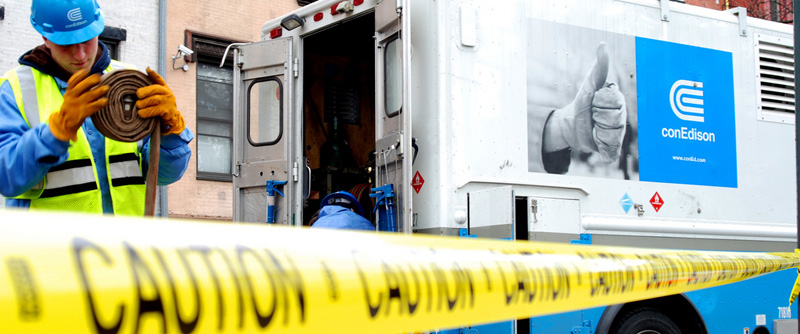The wires and pipes that power New York City could wrap around the earth nearly four times. But deferred maintenance and a lack of accountability make Con Ed a ticking time bomb.
The clock read 5:54 as Clayre Brown stood in the break room, speaking into the telephone. The svelte 27-year-old tried to wrap up her conversation with her younger sister so that she could get back on the floor. As manager of the newly opened bar and restaurant Public House New York, Clayre knew that the evening rush would soon overtake the staff if she didn’t get down to help. She wished her sister good luck in meeting a friend a block away at Grand Central Station and hung up the phone.
Descending the steps, Clayre emerged into the red-brick dining area, surveying the 100 or so customers gathered around the bar and seated at tables. The register flashed “Wednesday, July 18, 2007, 5:57.” She ducked behind the bar to raise the volume on one of the many flat screen televisions tuned into local baseball channels. That’s when she heard the rumble. It was distant at first, a low growl like thunder. The sound grew louder, like an approaching subway train, escalating to a deafening roar. Her heart began to pound in her chest as she scanned the sea of puzzled faces.
A woman screamed, and people frantically lurched into action, sending bottles and glasses crashing to the floor. Women literally ran out of their heels, some lunging towards the front doors, while others ran deeper into Public House toward the kitchen. Through the glass entranceway, Clayre watched the sky fill with a dark fog, changing from a clear blue to a murky charcoal. Pedestrians outside looked left in horror and ran east down 41st Street, away from Lexington Avenue. She sprang into motion, signaling patrons to leave through the kitchen. “It’s blown up!” she heard a man cry. “They’ve gotten Grand Central!” Clayre stopped suddenly, fear rising up through her throat, stinging behind her eyes. Trembling, she thought, “Oh my God, my sister.”
A few minutes elapsed while she rushed the remaining customers and workers out the back. Only Clayre, another manager, and the store owner stayed behind to turn off the kitchen equipment. The shock and fear for her sister blurred into a dull panic as she shut off stoves and ripped plugs from their sockets. The clock blinked 6:11 when they reached the street, locking the front doors behind them. Firefighters crouched behind a nearby wall, guarding themselves from shooting debris and airborne concrete crashing onto pavement. Black soot rained from above.
“It’s a steam pipe!” a firefighter yelled over the boom of gushing asphalt. “It burst underground at Lex and 41st!” Clayre’s mind raced to comprehend. A steam pipe? She looked west to see the geyser of gas and sludge. She swelled with relief. After running a safe distance from the Midtown eruption, she finally reached her sister on her cell phone. “Meet me at the apartment,” she demanded. “I’ll be there soon.”
Months later, in mid September 2007, the two blocks of Manhattan where the explosion had occurred remained blocked off. From Park to Third Avenue on 41st Street, neon orange hardhats swarmed around a gaping hole in the cement. It looked as if the earth had shifted, the pavement folding in on itself. Mountains of dirt and dusty cranes still lined the street, perfumed by natural gas and soil, just outside of Public House New York.
Clayre continues to work at the pub, but the incident severely rattled her. It’s hard for her to take the subway. The rumble of an approaching train sends chills through her body, flooding her senses with memories of July 18. “It was a life-changing experience,” she said. “It does make me wonder what could happen in the future.”
Many other New Yorkers also have questions about the safety and reliability of Con Edison’s underground utility infrastructure, now more than a century old. Blackouts; electrocutions; steam pipe explosions—far from anomalies, these are becoming regular events, with increasingly serious consequences. Following an investigation, the New York State Public Service Commission, the government agency that regulates utilities, attributed the incident to the company’s lax management practices. As experts predict that infrastructure catastrophes will escalate in the future unless something is done, local civic leaders are rallying for change.
“The fact is that Con Ed is badly mismanaged,” says Democratic State Assemblyman Michael Gianaris. Following a week-plus-long blackout in his district in 2006, he has made the taming of Con Edison his singular quest.
“How many disasters will Con Edison preside over before we realize the need to reform this unaccountable monopoly?” he asked in July 2007, immediately following the steam pipe explosion. “Until Con Edison faces consequences for its failures, we can expect continued catastrophes to occur year after year.”

